Analyzing the Price of Mobility: Desktops vs. Laptops
by Jarred Walton on September 7, 2013 5:55 PM ESTGPU/Graphics Performance Discussion
The other area of performance we want to look at is the GPU/graphics side of the equation. Where CPU performance has really started to level off – only overclocked CPUs or hex-core/octal-core options really hold serious performance advantages over the fastest mobile CPUs, and then only in heavily threaded workloads – the same can’t be said of graphics chips. Part of the problem is power requirements, as high-end desktop GPUs can draw up to 300W under load, which is three times what the most powerful mobile GPUs are rated to draw. The form factor also comes into play, but really I think power is the far more limiting factor.
Of course, there's a big difference in terms of what we do with CPUs vs. GPUs and how we do it. Most CPU-intensive tasks don't easily scale beyond a certain level of multi-threadedness, and some tasks really don't scale at all. The easiest example is anything that requires user input: no matter how fast your CPU gets, Word isn't going to type any faster than your fingers can go – or if you use speech recognition, any faster than you can dictate. Graphics on the other hand is practically infinitely parallel, where we can break things down into smaller and smaller pieces of a screen being rendered/computed by individual GPU cores. Many tasks on the CPU don't scale beyond four or maybe eight cores, but graphics is easy to scale to thousands of cores and beyond. So GPUs can get as large/fast as we can conceivably make them and there are still ways to tap into that performance potential; that's why modern systems typically have GPUs that consume two to ten times as much power as the CPU(s).
Let’s again put together some comparisons, only this time we’re a bit more limited in what we’ve tested with modern GPUs – on our desktop tests, we only have an overclocked GTX 680 and a GTX 780 with all of our gaming results, while on mobile we have a few additional reference points. I’ve also added Bioshock Infinite and Sleeping Dogs numbers for additional GPUs from our GPU 2013 test suite, but that’s only two of the seven titles we’re testing on laptops. We’re now looking at entire systems, but the GPUs are the primary factor in gaming performance. Also note that our reference point (1080p Max Detail, usually with anti-aliasing) is far more demanding than what most gamers actually require, but in terms of a performance discussion at least we can get an idea of where mobile GPUs stand.
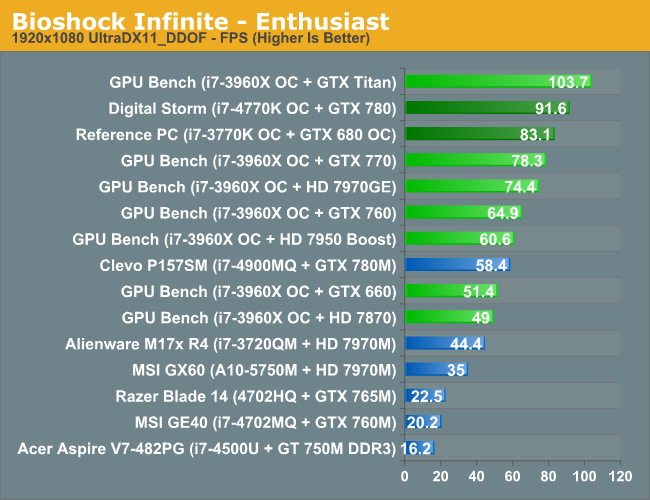
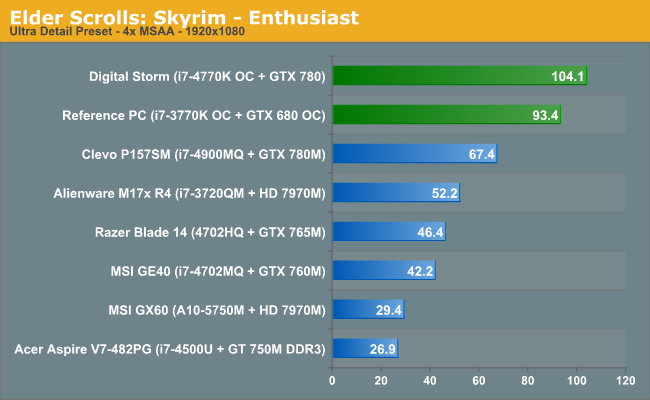
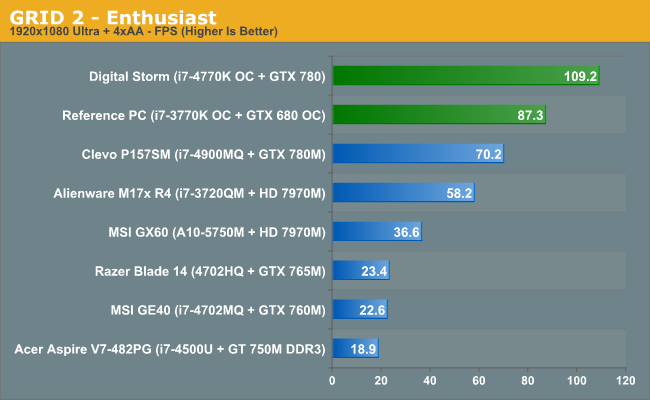


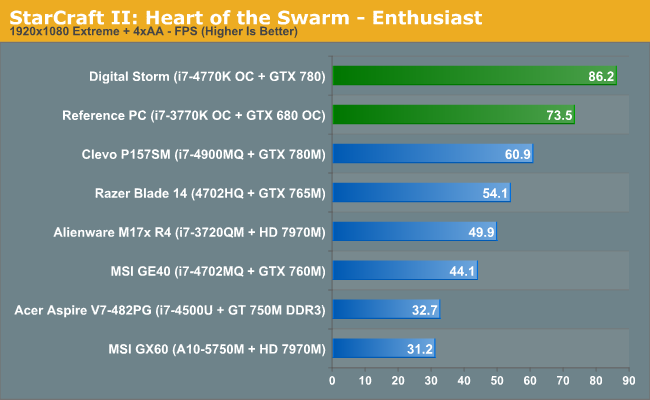
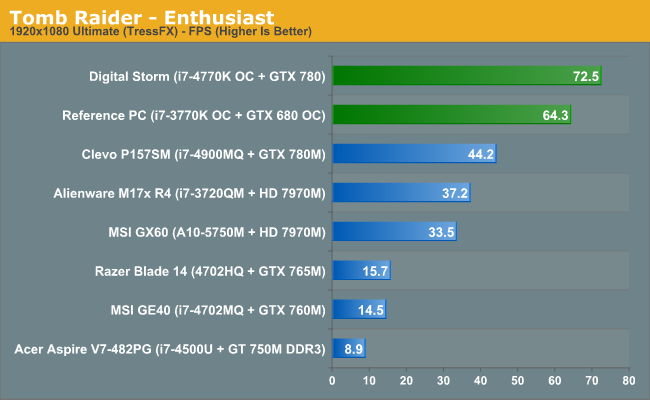
As far as replacing gaming desktop performance with a notebook is concerned, we’re nowhere near close to accomplishing this task. CPU requirements for the vast majority of users have reached a plateau during the past five or so years, but for graphics (games) we can still use pretty much all the horsepower available. The fastest mobile GPU we have right now, the GeForce GTX 780M, ends up delivering performance that falls roughly half way between the GTX 660 and GTX 760, or if we look at the Digital Storm system Dustin tested, it offers 60-70% of the performance of that desktop. Moving down to the lower performance mobile GTX parts like the GTX 765M, we haven’t tested any desktop GPUs in recent history that are anywhere near that slow – even the GTX 660 tends to be more than twice as fast as the GTX 765M and the GTX 560 Ti is still 50% faster. Drop one level further to the GT 750M (DDR3) and performance is about 60-80% of the GTX 765M! It’s not that you can’t game on a GT 750M or GTX 765M, but you’ll definitely need to drop the details down from max and turn off anti-aliasing. Finally, no matter what you do with a notebook, you’re not going to match the performance of the fastest desktop GPUs – the GTX Titan nearly doubles the performance of the GTX 780M, and even SLI GTX 780M isn’t likely to beat a Titan on a consistent basis.
Looking at pricing is also illuminating. Most notebook vendors charge around $650 (give or take) for a second GeForce 780M on the Clevo P370SM, compared to the desktop GTX 760 (which has slightly higher performance) that can be purchased for $250. Meanwhile, the desktop GTX 780M sells for the same $650 price as the GTX 780 while offering only 60-70% of the performance you get from the desktop GPU; the GTX 680 and GTX 770 have the same number of CUDA cores (1536) and go for $400, delivering superior performance at a substantially lower cost. The pattern continues as we move down the product stack; the slowest desktop Kepler, the GeForce GT 630, is a $65 card that has slightly higher clocks than the GT 750M, never mind the GT 730M and GT 740M, but the GT 730M is typically a $70 upgrade on a notebook. The GTX 765M has the same number of cores as the $130 GTX 650 Ti but with lower clocks; it reputedly sells for close to the same price to laptop OEMs as the desktop GTX 760 we mentioned as a performance equivalent of the GTX 780M.
Of course, where you can easily add a GPU to most desktops, with laptops you’re basically stuck with whatever you initially purchase. I noted in the Gaming Laptop Guide last month that the lowest price I could find for a notebook with a GTX 780M ends up around $1750 (including the OS with a 1TB HDD). For equivalent performance (more or less), we can take the desktop we listed above and add a GTX 760 GPU, with a slight PSU upgrade as well just to be safe. Here’s what we end up with:
| Mainstream Gaming Desktop PC | ||
| Component | Description | Price |
| CPU | Intel Core i5-4670 (Quad-core, 3.4-3.8GHz, 6MB L3, 22nm, 84W) | $200 |
| Motherboard | ASRock Z87 Pro3 LGA-1150 | $115 |
| GPU | GeForce GTX 760 | $250 |
| Memory | 2x4GB DDR3-1600 CL9 1.5V RAM | $65 |
| Storage | Seagate 1TB 7200RPM HDD | $70 |
| Optical Drive | SATA DVDRW (Lite-On) | $18 |
| Case | Antec Three Hundred | $60 |
| Power Supply | Rosewill Green RG530-S12 530W 80 Plus Bronze | $55 |
| Operating System | Windows 8 64-bit (OEM) | $100 |
| Total | $933 | |
Opting for a gaming notebook thus carries a hefty price premium, nearly doubling the price of a similar performance desktop. Yes, the notebook still gives you a battery, display, keyboard, touchpad, and speakers as part of the package, but if you already have those for an existing desktop they’re not really necessary. The price premium for high-end gaming notebooks has certainly come down from the 2x-3x we used to see (though you can still get to that range with SLI notebooks), but we’re nowhere near parity like we are on the CPU side of things. As an alternative, desktop GPUs are also able to hit much higher performance levels at a similar cost to a high-end gaming notebook.
Given the various options, many people have concluded that it’s far better to have a decent gaming desktop like the one above and then to spend another $500-$1000 on a good laptop for when you need to go mobile. That’s generally my recommendation as well – for all the gaming notebooks I’ve reviewed over the years, I still turn to my desktop system 95% of the time when I’m looking to play a game. On the other hand, not everyone wants to worry about having two computers and syncing data between them, and there are also space limitations to consider. Finding a spot for a 10 pound gaming notebook in a college dorm is easy enough; finding space for a gaming desktop with display, speakers, keyboard, and mouse can be a bit more difficult. And if you’re regularly on the road and want to take your games with you, you’ll need the laptop regardless.
There’s no right answer for how to do things, of course. Some people love gaming notebooks and others don’t see the point. But while you can certainly make a case for typical notebooks/laptops now being close to price parity with similar performance desktops, once you add gaming into the mix you’ll need to pay the mobility piper his due.










110 Comments
View All Comments
BlakKW - Sunday, September 8, 2013 - link
Thanks for the article...it was interesting, and results were not entirely what I expected them to be.Selbatrim - Sunday, September 8, 2013 - link
This has partially been picked up but I think this article is a bit of old rubbish myself. The laptop in question firstly uses a 5400rpm HDD and does not include an optical drive. Additionally the desktop system is a custom build with plenty of room to shave off cost. Case and PSU easily reduced by $50, motherboard too. I'd say (including dropping the GPU) you would reduce the price of the desktop by about $400 and still have a higher performing device.And this is still a custom build, not an OEM build.
I've just priced up a laptop vs desktop replacement for our fleet and the desktop (including peripherals) come in at about 60%-75% of the cost of a laptop (depending on portability). Add to that you mostly need to factor in a port replicator for the laptop the desktop wins hands down.
Can you get a reasonably priced laptop these days that will do general computing for less then $1000? Sure. Can the same money buy you a much better desktop? You betcha.
wintermute000 - Sunday, September 8, 2013 - link
Yeah around 1/3rd cheaper sounds around right (+ expandability, repair, upgrade path etc.)JarredWalton - Monday, September 9, 2013 - link
I looked at pre-built OEM PCs and none of them really came in much cheaper than the custom build without serious compromises on some areas. Getting a cheap $25 case and $25 PSU is also a bad idea, so I specifically went against that and included a decent case and a good quality 80 Plus Bronze PSU -- even the OEMs are avoiding crap PSUs these days.Except... crap, my tables on the desktop are screwed up. There are supposed to be two different builds, one for gaming, one for "standard" use (no GPU). Let me fix that, because the mainstream desktop isn't all that different but costs $200 or so less.
JarredWalton - Monday, September 9, 2013 - link
Okay, fixed the table. Sorry about that -- funny that you're the first to notice. I had the text right (it mentioned the $672 price), but somehow copied the same table into the document from my spreadsheet.Selbatrim - Monday, September 9, 2013 - link
I'd not recommend a rubbish psu either but Seasonic is a high end brand. As is the Z87 chipset. If quality and durability is part of your desktop build then you should chose the same in your laptop. A HP Envy is not a high quality laptop. It is pretty much a mid-lower end in terms of build quality.The issue of the HDD speed comparing a desktop 7200 rpm to a laptop 5400 rpm will also have a major impact on performance (or drop the price on the desktop). But even still, your results point to a laptop of SIMILAR specs being comparable if not competitive with a desktop and this is simply not true.
Asrock H81M-HDS motherboard for $52 (save $63)
COUGAR Solution Black Steel ATX Mid Tower (INC 400W 80+ PSU) $80 (save $24)
No Optical drive (Envy does not have this. Save $18)
Total now of $567 and you still have a better CPU and HDD.
Again, yes, you get better laptops now than you used to and you can easily replace your desktop with a laptop but it will cost more (and you still need extra monitor, keys etc to use it full time or suffer the consequences)
ChuckEX - Sunday, September 8, 2013 - link
I will always browse through and appreciate articles on computer performance, but for me, they will only serve as guides. It amazes me how people fail to take into account "real world performance". Of course, on the bench, the numbers say anything other than the most bleeding edge hardware and you are missing out.I'm rock'in an extremely humble laptop with an AMD A6 4400m chip. I paid $300 open box for it, removed all the bloatware, maxed out the RAM (from 4GB to 8GB) and got a quality Thermaltake cooling pad. I've played through Skyrim, Tomb Raider (2013), Dishonoured, Bioshock Infinity and tons of other "demanding" games. I'm currently playing Splinter Cell: Blacklist no problem. Granted, my graphics settings are low/medium, however, these games still look and play great.
I guess it's just down to personal preference. If you're gonna chase the numbers, you'll never be satisfied. If you tone it down and have realistic expectations, you can have just as much fun as everyone else. I think computer graphics have reached a plateau. Everyone goes on about how beautiful a game looks on the PS3/XBox 360 to this day - 7 year old technology! And tablet games are looking better and better.
Don't get me wrong. I've had many PC builds and I aspire to get the most bang for my buck. I'm just blown away at what I'm able to do with this humble little laptop.
JarredWalton - Monday, September 9, 2013 - link
I get what you're saying, and certainly turning down details can help, but some of the games you mention I have trouble believing they run well at all on an A6-4400M iGPU (HD 7520G). That's half the performance of the 7660G, which struggles with several of the games on our list (Tomb Raider at Low detail is 48FPS average, so I suppose it might get >30FPS at 1024x768 at Low, Bioshock is a similar story, and even Skyrim is going to be borderline at best -- Notebookcheck shows <30 FPS for Skyrim for instance (http://www.notebookcheck.net/AMD-Radeon-HD-7520G.7...The thing is, while I have no trouble saying "Medium 1366x768" is usually fine for quality -- it's the gameplay, right? -- there are many cases where "Low 1366x768" does not even compare. GRID 2, StarCraft II, Skyrim, and others look really bad at "Low" as opposed to "Medium". You might be okay with those setting, and they're going to be necessary on an A6-4400M, but I would not be happy with the overall experience.
KalTorak - Monday, September 9, 2013 - link
"Part of the problem is power requirements, as high-end desktop GPUs can draw up to 300W under load, which is three times what the most powerful mobile GPUs are rated to draw. The form factor also comes into play, but really I think power is the far more limiting factor."I don't see the distinction you're drawing in that last sentence; isn't it the form factor that determines the power constraints?
JarredWalton - Monday, September 9, 2013 - link
Perhaps somewhat, but a desktop GPU can suck down 300W (sometimes more for the dual-GPU on a PCB models), and the largest power brick I know of for laptops is rated at 300W. So form factor is part of the issue, yes -- you can only cool so much heat in a notebook -- but without 450W power bricks for notebooks you're never going to touch the performance of a desktop that draws 450W.